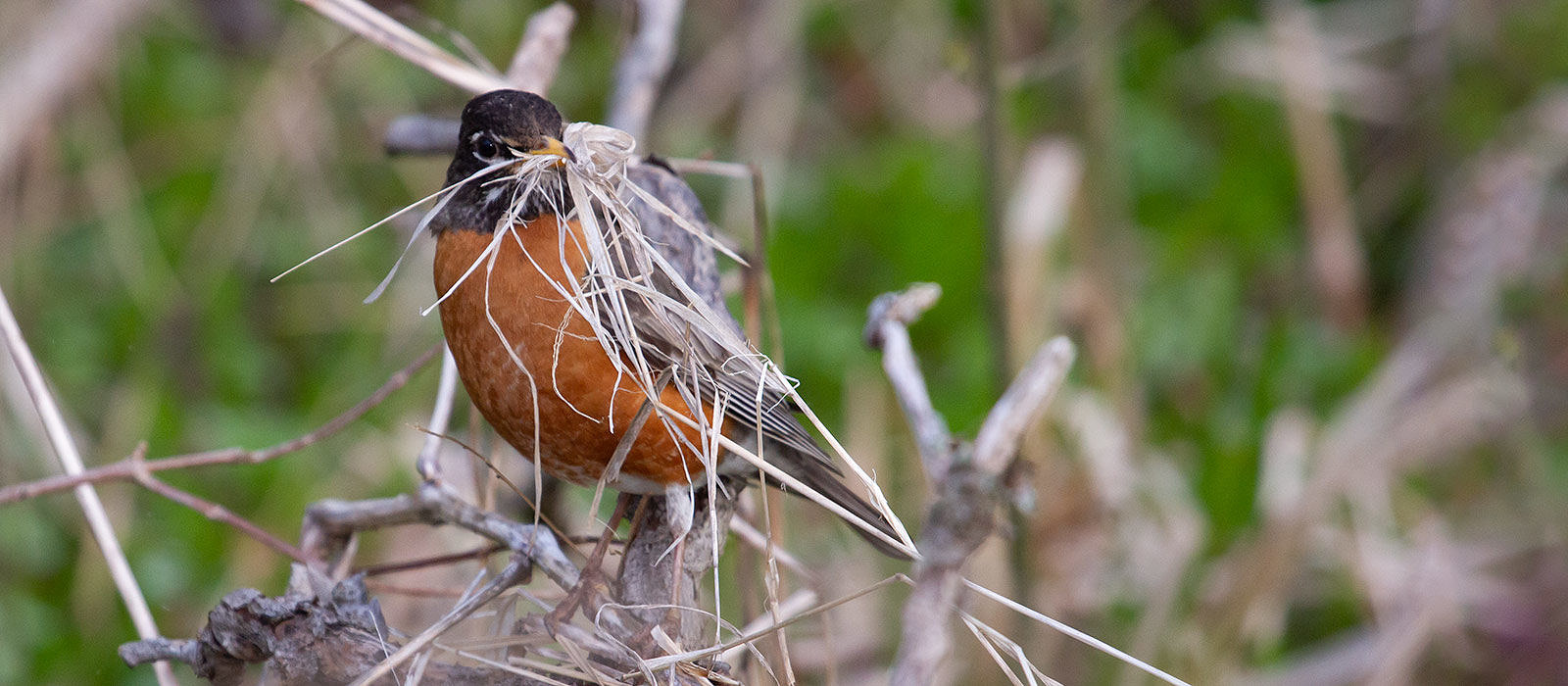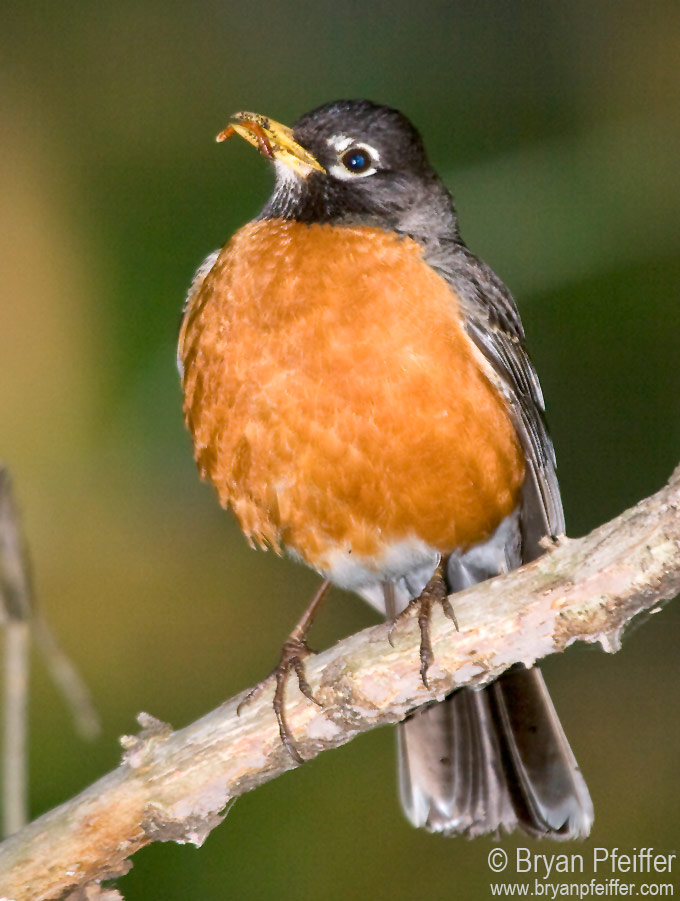
Why the American Robin is a Badass Bird
From his perch near a bog in remote northern Vermont, far from suburbia and barnyards, an American Robin sings as if he owns the place. And, in many ways, he does.
The robin is a paragon of versatility — a songbird of north, south, east, and west — covering forested and fragmented habitats across the continent. Few other birds can claim such a range. Hardly a placid suburbanite, the American Robin conquers territory with a blend of moxie and manifest destiny.
Food figures big in this story of avian dominance. The robin does not live by earthworm alone. Changing diet with the seasons, the robin tugging worms from your lawn this spring may move to high peaks to feast on mountain ash fruits once snow falls. On the way, he’ll graze on anything from beetles to spiders, from the fruits of poison ivy to the cones of junipers. A study of stomach contents from 1,169 robins featured fruits of 50 genera and invertebrates from more than 100 families.
 That kind of diet requires dexterity. A robin hunting earthworms will pause, wait, watch, and adjust its gaze before striking. But robins also run down and nab dashing insects, or probe the forest floor by flipping leaves and twigs. On the wing, they can snatch fruits off the vine. On rare occasions, robins have been found to have eaten fish, frog, snake, skink and maybe even bird brains (more on that in a bit).
That kind of diet requires dexterity. A robin hunting earthworms will pause, wait, watch, and adjust its gaze before striking. But robins also run down and nab dashing insects, or probe the forest floor by flipping leaves and twigs. On the wing, they can snatch fruits off the vine. On rare occasions, robins have been found to have eaten fish, frog, snake, skink and maybe even bird brains (more on that in a bit).
The varied diet helps make robins our most cosmopolitan songbird — from boreal forests in Alaska to dairy farms in New England to shopping malls in Miami. In the fir and hemlock forests of the American and Canadian West, I find robins to be regular nesting birds, perhaps more so than in softwoods here in the East, although research suggests robins prefer early-successional forests. As we humans cleared and fragmented forests for homes, parks, and commerce, robins followed in our wake. They thrive in edge habitats that include riparian zones, city parks, and even new settlements in the formerly inhospitable Canadian arctic. (That robin in the banner image above was gathering nesting material in rural Ohio in early May.)
Once they claim turf for breeding, robins tenaciously defend their nests from predators with what seems to be an enhanced version of the songbird arsenal: harassment, gang warfare, and an occasional good thrashing. Confronted with a raccoon, squirrel, crow, or hawk at the nest (or even a human wandering too close), robins spring into a dance of agitation: they hop from perch to perch, flick their wings, wag their tails, and blurt emphatic, staccato yeep! and chuck! calls. These antics often draw additional robins and other songbirds into the fray. Lacking talons or hooked beaks, songbirds go for strength in numbers.
Occasionally, robins make at least glancing contact with a predator, usually around the head and neck. One robin was reported to have killed a Steller’s Jay by thrashing the jay with its wings and feet and then pecking at — and penetrating — its head. (Ouch, I think that’s gonna leave a mark.)
If that isn’t enough, robins are pushy. When they head south in fall they don’t go too far — some winter as far north as southern Quebec and central Maine. By pushing the northern edge of their winter range, robins (mostly males) linger near the front of the line so that they can be first to claim high-quality territories and the spring buffet of fruits and insects.
With its undiscriminating diet and brash behavior, the American Robin is a lot like, well, a lot of other Americans.

Having raised a robin or two for over 20 years, I know a bit about robins.
The LOVE electronic toys such as computers, pads, calculators, tv’s. They learn how to operate such devices by observing humans operate them. No kidding! It is possible to teach a robin how to navigate a simple device in less than an hour.
It is as ineffective to determine a traditional “wild” animal’s IQ in the wild as it would be to determine a child’s who goes to school to get tested on days it is hungry, sick, anxious, sleep deprived, hearing deficient, sight deficient, in a foreign language, physically abused, or mentally abused.
Last year I had a visit from a juvenile Barred owl and let me tell you that the Robins did not like him one bit. They looked like kamikaze pilots flying straight into the owl (who was just shrugging the robins off) but they didn’t stop until the owl left the area. Brave and badass indeed
February 2021… Cleburne Tx…. I watched as hundreds of American Robins take over my Yopon Holly trees. All 4 trees were stripped bear of the red berries in a matter of minutes.
I have three babies in a nest on my pergola just outside my back door. Both mom and dad (I guess) are EXTREMELY protective. I normally enjoy my coffee sitting out and watching “my birds” as they feast on one of the many feeders I keep stocked with seeds…no more!
Louisiana
Ours as well!
Our morning alarm.
Supporting data! 🙂 Thanks, Roberta!
A couple of weeks ago I looked into my backyard and saw two robins duking it out. Feathers were flying as they rolled around on the ground, one on its back being thrashed by the other one. This went on for over a minute. Baddass for sure!
Many years ago I watched a robin torment a large snake as the snake tried to climb the wall of a state park outhouse towards the robin’s nest at 1000 Islands NY. After about an hour the snake finally gave up and slithered off into the woods